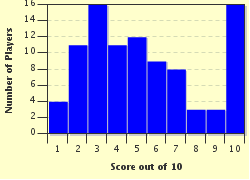Quiz Answer Key and Fun Facts
1. Although this man is often styled as Louisianian, he was in fact a North Carolinian, having been born in the Tarheel State. He commanded the Confederate Army of Tennessee in the battles of Perryville, Murfreesboro (Stones River), Chickamauga and Chattanooga. Who was he?
2. This man was a transfer to the Confederate States Army from the Army of the Lord. He was a "Fighting Bishop". In the Battle of Perryville, on September 8, 1862, when he saw his subordinate, Benjamin F. Cheatham, saying "Give 'em hell, boys!" he replied "Give 'em what General Cheatham says!". Who was he?
3. This man was brother-in-law to Stonewall Jackson and friend of James Longstreet and Joseph E. Johnston. Before the Civil War, he had written a textbook, "Elements of Algebra" and, after the war, he became the editor of "The Land We Love". Who was he?
4. This North Carolinian received the thanks of the Confederate Congress on May 17, 1864 for his gallantry at the Battle of Plymouth, where he captured close to 3,000 Union soldiers. He also served with distinction at Cold Harbor, acknowledged by Union general Ulysses S. Grant as his greatest failure. Who was he?
5. This man had the distinction of being promoted to brigadier general on the battlefield of Seven Pines by President Davis himself. Moreover, during the reorganization of the Army of Northern Virginia following Stonewall Jackson's death, General Lee wrote to President Davis that he was: "an excellent officer, attentive, industrious and brave; has been conspicuous in every battle, and, I believe, wounded in almost all of them". Who was he?
6. This North Carolinian was one of the youngest Confederate Generals. His performance at Chancellorsville was very astounding and his command had the highest percentage of losses for all the Confederate brigades at Chancellorsville. Who was he?
7. This North Carolinian was known to have been friends with Union general Winfield Scott Hancock. At the third day of Gettysburg, his brigade penetrated the furthest of all Confederate units at the Pickett-Pettigrew-Trimble charge, achieving the high water mark of the Confederacy. Who was he?
8. This North Carolinian was not only a general, but also an author, diplomat and polyglot. He wrote a book entitled "Notes on Spain and Spaniards" and spent time in diplomatic service there. He could speak French, German, Spanish, Italian and write in Greek, Hebrew and Arabic. He also uttered the quote "The post of danger is certainly the post of honor". Who was he?
9. This North Carolinian deserves much credit for halting the Union breakthrough in the "Bloody Angle" on May 12, 1864, at the Battle of Spotsylvania Court House. Moreover, towards the end of the war, he helped catch deserters from the Petersburg trenches. Who was he?
10. In Raleigh, the state capital of North Carolina, there is a statue erected to Private Henry Lawson Wyatt, a Confederate soldier from the state. What was special about Wyatt, which resulted in the erection of the monument to him?
Source: Author
DeepHistory
This quiz was reviewed by FunTrivia editor
bloomsby before going online.
Any errors found in FunTrivia content are routinely corrected through our feedback system.

